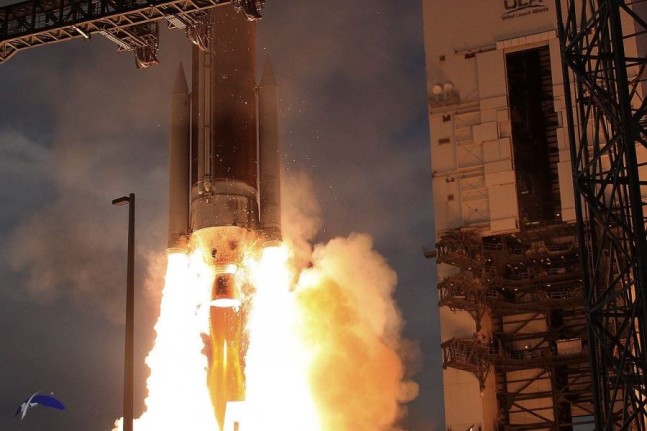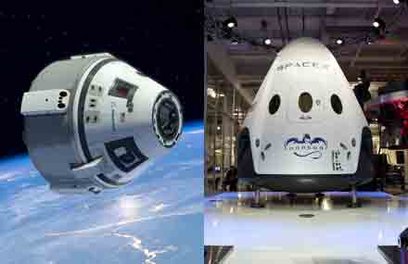September 18, 2014 – Quietly lost in the background of this week’s NASA announcements is the news that Jeff Bezos’ company, Blue Origin, is to provide United Launch Alliance, owners of the Atlas V rocket, with a next generation engine technology for a next generation rocket. Although Boeing and SpaceX got the major headlines as the companies selected to provide crew-manned capsules for the International Space Station (ISS), Blue Origin may have the last laugh.
In inking an agreement with United Launch Alliance the two will jointly develop a next generation rocket engine, the BE-4. This will finally end United Launch Alliance’s use of the RD-180, a Russian-built rocket. In any case the Russians recently threatened to cut off the supply of RD-180s to U.S. launchers. So the timing is perfect.
Blue Origin recently conducted a test firing of its BE-3, a liquid hydrogen/liquid-oxygen powered rocket engine producing 110,000 pounds of thrust. The BE-4 however will use liquefied natural gas/liquid oxygen. Each engine will generate 550,000 pounds of thrust upon launch.
The successor rocket to the Atlas V will include two BE-4s combining to produce over 1.1 million pounds of thrust at liftoff. Full scale testing is scheduled for 2016 and first flight by 2019. For Atlas and Delta rockets (one photographed below during launch courtesy of Mike Howard, SpaceFlgiht Insider), the latter also using Russian technology, the BE-4 may become the rocket engine of choice.
The other news of course was focused on Boeing and SpaceX, chosen to provide commercial crew capsules to NASA for use in flying to the ISS starting in 2017. This will end American dependence on Russia’s Soyuz as the sole way for astronauts to get access to near-Earth space.
Was anyone surprised the Boeing and SpaceX were chosen? Certainly not me. Boeing the incumbent has had a long relationship with NASA and was heavily involved in development of the Apollo space capsule. Its Boeing-branded successor goes by the name, CST-100 (which is an acronym for Crew Space Transportation and the 100 kilometer altitude which marks the boundary between the Earth’s atmosphere and space). Boeing will receive $4.2 billion US from NASA to deliver a minimum of two and a maximum of six crews to the ISS.
The junior partner in this announcement, SpaceX, is the developer of the Dragon, currently being used to ferry supplies to the ISS. Dragon is the only capsule being used today that is capable of bringing back experiments and materials from ISS. In future SpaceX intends to have Dragon capsules perform controlled landings Buck Rogers style, on land. It is receiving $2.6 billion US from NASA and will also be responsible for two crewed flights and potentially a maximum of six.
For NASA partnership with commercial space carriers will be the route to go for the foreseeable future.
Left out of the mix but not necessarily out of the race to near-Earth space is Sierra Nevada. The sexy Dream Chaser, a capsule resembling a mini-space shuttle may not get NASA contracts, but that doesn’t mean others won’t adopt Sierra Nevada’s technology for sending crews to space. And Blue Origin, with its own crew capsule, the Space Vehicle, may also find customers. That’s because there are a growing number of national space programs and commercial operators all seeking human access to near-Earth orbit. It won’t be long before the current three nations that have launched humans into space, Russia, the United States and China, find other company in orbit. And China has plans for its own space station while Bigelow Aerospace, another U.S. company is well on its way to building the first near-Earth orbit space hotels with its inflatable modules.






















It would be nice if, rather than just lift the picture from SpaceFlightInsider.com – you cited the source of the image To see where 21stcentech lifted it from: http://www.spaceflightinsider.com/organizations/ula/ula-blue-origin-announce-partnership-develop-new-rocket-engine/
Thank you for making me aware of this oversight. The copy now references the photo credit.